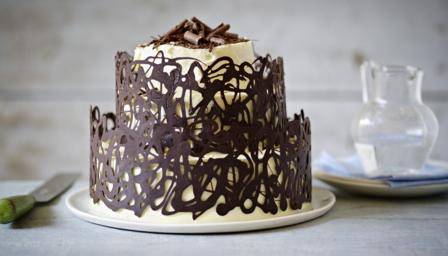Chocolate creation showstopper

Method
-
Preheat the oven to 180C/350F/Gas 4 (fan 160C). Grease and line two 20cm/8in deep sandwich tins, one 15cm/6in cake tin and one 10cm/4in cake tin with baking parchment.
-
For the chocolate cakes, blend the cocoa powder and 200ml/7fl oz boiling water in a large bowl. Add the remaining cake ingredients and beat until the mixture has become a smooth, thickish batter.
-
Divide the cake mix between the prepared tins, filling the sandwich tins half full and the two cake tins two-thirds full. Level the surfaces.
-
Place all four tins on the middle shelf of the preheated oven and cook the sandwich tins for about 25-30 minutes, the 10cm/4in cake tin for 35-40 minutes and the 15cm/6in cake for 45-50 minutes, or until well-risen and the tops of the cakes spring back when lightly pressed with a finger. (If the tins won't fit on the same shelf place the 15cm/6in cake on the shelf above and move it down to the middle shelf as soon as possible - this may reduce the cooking time slightly.) Leave to cool in the tins for a few minutes and then turn out onto a wire rack, peel off the parchment and leave to cool completely.
-
For the white chocolate ganache, break the white chocolate into pieces. Heat the cream in a pan until just hot enough to melt the chocolate. Drop the chocolate pieces into the cream and stir until they have all melted.
-
Remove from the heat and leave to cool until stone cold. Beat the cream cheese in a bowl to soften it, then gradually beat in the cold chocolate cream mixture. You may need to set aside the mixture in the fridge for 15 minutes to thicken up.
-
To assemble, cut the 15cm/6in and 10cm/4in cakes in half horizontally and sandwich them together with some of the white chocolate ganache. Sandwich the 20cm/8in cakes together with more of the white chocolate ganache and stack the cakes on top of each other with the sandwiched 10cm/4in cake on top, the sandwiched 15cm/6in cakes in the middle and the 15cm/6in sandwiched cake on the bottom. Set aside the rest of the ganache.
-
Warm the apricot jam in a small pan and brush it all over the stacked cakes. Using a palette knife, spread the remaining white chocolate ganache over the cakes to cover. If your kitchen is hot you may need to place the cakes in the fridge to allow the ganache to set.
-
For the chocolate lace collars, break 150g/5½oz of the plain chocolate into a bowl set over a pan of simmering water. Stir until the chocolate reaches a melting temperature of 47C/115F (use a kitchen thermometer to check). Remove the bowl from the heat, add the remaining 50g/1¾oz of chocolate and stir until the chocolate has cooled to 31C/90F.
-
Cut two strips of greaseproof paper or acetate 10cm/4in wide and long enough to wrap around the middle-sized and the large cakes. (They will need to be about 10x55cm/4x22in for the middle cake and about 10x70cm/4x28in long for the large cake.) Place the strips on a work surface.
-
Pour the chocolate into a piping bag fitted with a writing nozzle and let the chocolate fall out of the bag while swirling up and down the strips of greaseproof to create a lace effect. (Don’t worry if the chocolate falls outside of the paper strips, just be sure to move the strips of paper before they set so that they don’t stick to the work surface). Leave to cool until just set and firm enough to wrap around the base and middle layer of the cake leaving the acetate on (about 15 minutes).
-
Leave to set completely (about one hour) before peeling off the greaseproof or acetate paper. Don’t be tempted to set the chocolate collars in the fridge as this will cause the chocolate to be dull and not have a shine when you remove the paper. Decorate the outside of the bottom and middle cakes with the chocolate lace collars.
-
For the chocolate curls, break the plain chocolate into a bowl set over a pan of simmering water. Stir until the chocolate melts and then pour over a cold marble or granite surface. Leave to cool until just set. Using a cheese slicer, gently slice from the top of the chocolate down to the bottom, to create chocolate curls. Sprinkle the curls over the top tier of the cake.
Ingredients
For the chocolate cakes
- 125g/4½oz sifted cocoa powder
- 6 large free-range eggs
- 100ml/3½fl oz milk
- 350g/12oz self-raising flour
- 1 tbsp baking powder
- 200g/7oz softened butter, plus extra for greasing
- 550g/1lb 2oz caster sugar
For the white chocolate ganache
- 400g/14oz white chocolate
- 300ml/10fl oz double cream
- 300g/10½oz full-fat cream cheese
- 6 tbsp apricot jam
For the chocolate lace collars
- 200g/7oz plain chocolate (70% cocoa solids)
For the chocolate curls
- 200g/7oz plain chocolate (68-70% cocoa solids)
Shopping List
Chocolate creation showstopper
Tins, packets and jars
Cooking ingredients
Biscuits, snacks and sweets
Dairy, eggs and chilled